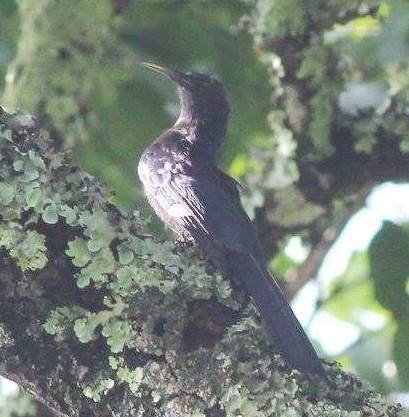Abyssinian Scimitarbill Bird Details
Rhinopomastus minor
Abyssinian Scimitarbill
NA
Wilhelm Peter Eduard Simon Rüppell, 1845
Bucerotiformes (HOOPOES and HORNBILLS)
Phoeniculidae
Rhinopomastus
Ethiopia, Kenya, Somalia, Sudan, Tanzania, and Uganda.
Appearance :
The Abyssinian Scimitarbill is a medium-sized bird with a distinctive curved bill resembling a scimitar. It has a greyish-brown plumage with a pale throat and darker streaks on the belly.
Behaviour :
It is typically seen singly or in pairs, often perched prominently on tree branches. It has a loud, distinctive call.
Habitat :
Found in savanna woodlands, dry forests, and thorn scrub habitats.
Diet :
Feeds primarily on insects, including ants, beetles, and grasshoppers, which it catches by gleaning from branches and foliage.
Conservation Status :
Least Concern
Distribution :
Found in East Africa, specifically in countries such as Ethiopia, Kenya, Somalia, Sudan, Tanzania, and Uganda.
Population Size :
Generally considered stable.
Life Span :
Live up to 15 years.
Body And Tarsus:
- The Abyssinian Scimitarbill has a slender and elongated body structure.
- Tarsus Length: Approximately 2.5-3.0 cm (1-1.2 inches).
Head And Bill :
- Head: The head is relatively small compared to its body.
- Bill: It features a long, curved bill that resembles a scimitar. The bill length is approximately 5-6 cm (2-2.4 inches).
Length :
Measures around 23-25 cm (9-10 inches) from beak to tail.
Neck :
The neck is short and not very visible due to the bird's posture and plumage.
Size :
It is medium-sized among birds, with a robust build.
Tail Details :
- Tail: The tail is relatively short.
- Tail Length: Approximately 7-9 cm (2.8-3.5 inches).
Weight :
Around 60-70 grams (2-2.5 ounces).
Wing :
The wings are broad and rounded, suitable for agile flight within its woodland habitat.
Wing Span :
Approximately 35-40 cm (14-16 inches).
Facial Feature :
The facial features include a pale throat and darker streaks on the belly.
Nest Details :
- Nest: The Abyssinian Scimitarbill builds its nest in natural cavities such as holes in trees or in abandoned nests of other birds. It does not construct a nest from scratch but rather modifies existing structures.
- Nest Made Up of: The nest is typically made up of dry leaves, grass, and other plant materials that are available in its habitat.
Breeding Season :
During the rainy season.
Nesting Season :
Nesting usually occurs during the same period as the breeding season.
Egg Color :
White or creamy-white in color, sometimes with speckles or spots.
Egg Length :
Approximately 2.5-3.0 cm (1.0-1.2 inches) in length.
Egg Width and Weight :
- Egg Width: Around 1.5-2.0 cm (0.6-0.8 inches).
- Egg Weight: Approximately 5-7 grams (0.2-0.25 ounces).
Clutch Size :
Usually consists of 2-4 eggs.
No. of Broods :
Raises one brood per breeding season.
Incubation Period :
Lasts for about 14-17 days, during which time the eggs are cared for primarily by the female.
Nestling Period :
About 20-25 days before fledging.
Vocalization :
The Abyssinian Scimitarbill is known for its loud, distinctive calls that can carry over long distances.
Sex Demorphism :
There is little to no observable sexual dimorphism in plumage or size between males and females.
Migration Details :
Non-migratory species.





